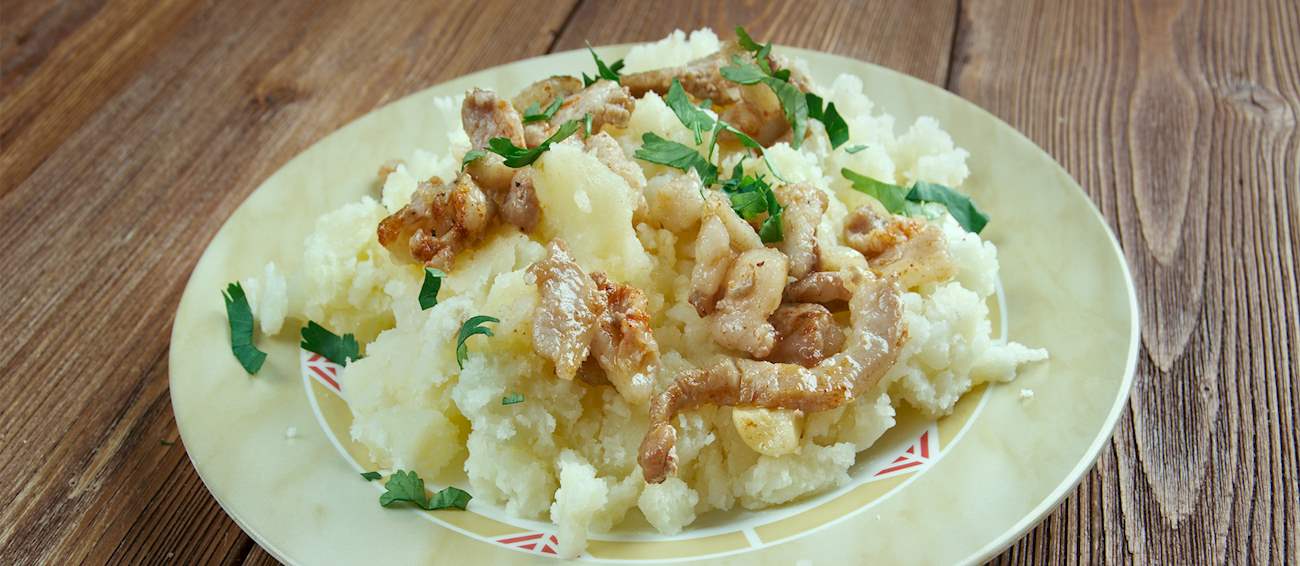Traditionally served for dinner on cold winter nights in the Netherlands, zuurkoolstamppot is a hearty dish consisting of a combination of mashed potatoes and sauerkraut. The dish is often enriched by the addition of butter and bits of bacon. It is customarily served piping hot and paired with rookworst sausages that are placed on top of the stamppot.
Hete bliksem is a traditional meal consisting of mashed potatoes, apples, and bacon. The name of the dish means hot lightning, referring to the fact that mashed apples keep mashed potatoes hot for a longer period of time, so the higher temperature can cause the burning of one's palate.
Recipes vary from one cook to another, but hete bliksem remains a favorite side dish of numerous Dutch families.
MAIN INGREDIENTS
Hutspot is a traditional, colorful Dutch dish made with potatoes, carrots, and onions. Today, it is a popular dish to eat during the cold winter days, but originally, it was prepared (and still is) on the 3rd of October, as the city of Leiden celebrates their victory over the Spaniards in 1574.
Potatoes, onions, and carrots are typically mashed together and seasoned with salt and pepper. The carrots should be full of natural sugar, such as the Dutch winterpenen carrot variety, gathered right after the first frost, giving the dish a special flavor.
MAIN INGREDIENTS
Ćoravi gulaš is a variety of goulash consisting of potatoes, onions, carrots, peas, and tomato juice. It is typically flavored with ground paprika, parsley, salt, pepper, bay leaves, and garlic. The stew can be thickened with flour, and it can be garnished with a dollop of sour cream.
The name of the dish can be translated as blind goulash, referring to the fact that this comforting stew does not contain any meat. The dish was especially popular during the war period in the 1990s, when meat was scarce, so people had to make use of readily available ingredients.
This classic casserole is one of the most popular Swedish dishes, which is often served for Christmas. It consists of potatoes and sprat fillets—do not mistake these with anchovies as it is suggested in many recipes—which are layered with onions and then doused in cream.
The top of the casserole is occasionally basted in butter and sprinkled with breadcrumbs before it is baked until golden. Although it is believed that this Swedish casserole appeared earlier, the first written recipe under the catching name of Janssons frestelse, translated as Jansson's temptation, appeared in 1940.
This traditional Finnish casserole is characterized by its long cooking time and a subtle sweetness. It is prepared with a combination of mashed potatoes and wheat flour that is stored in a warm place for hours, allowing the starch to break down and provide the natural sweetness.
The dish is sometimes additionally sweetened and seasoned with nutmeg before it is baked until a golden-brown, crispy crust forms on top. Traditionally associated with Christmastime, this creamy, starchy casserole is usually enjoyed as a side dish.
Stamppot, meaning mashed pot, is a traditional dish made from mashed potatoes and one or several selected vegetables such as kale, spinach, endive, turnip, or sauerkraut. If the potatoes are mashed together with onions and carrots, the dish is then called hutspot.
In addition to stamppot, bacon can be used as an accompaniment, but it is usually served with a smoked sausage or cooked meat on the side. The most popular variety of stamppot is known as stamppot boerenkool, consisting of potatoes mashed with kale.
VARIATIONS OF Stamppot
Granatir or grenadir marš is a simple meal consisting of pasta, onions, and potatoes. It is traditionally heavily seasoned with ground paprika. Due to the inexpensive ingredients and high content of carbohydrates, the dish is a representative of peasant food throughout continental Croatia, particularly in the region of Slavonia, where it is still prepared today.
If the pasta is made without eggs, this dish is suitable for vegans.
Tombet is a traditional Mallorcan vegetable dish consisting of baked layers of aubergines, red bell peppers, and potatoes which have previously been fried in olive oil. When served, tombet is typically topped with a combination of fried tomatoes, garlic, and parsley.
Visually, when presented, the dish looks like a crustless pie. Although tombet is usually served as a main vegetarian dish, it can also be used as an accompaniment to fish or meat. Nowadays, it is available at most Mallorcan restaurants.
MOST ICONIC Tombet
View moreConsisting of sausages, onions, slices of bacon called rashers, and potatoes, Dublin coddle is a typical winter dish. The name probably comes from the French word caudle, meaning to boil gently, while the origin of the dish dates back to the 1700s.
Allegedly, it originated from the habit of one-pot cooking employed by the sailors of Ringsend and was a favorite of both Jonathan Swift and Seán O'Casey, as well as mentioned in the works of none other than James Joyce himself. It was invented as a way to use leftovers and was typically prepared in bigger cities where it gained popularity because it was so easy to make.
MOST ICONIC Dublin Coddle
View moreTasteAtlas food rankings are based on the ratings of the TasteAtlas audience, with a series of mechanisms that recognize real users and that ignore bot, nationalist or local patriotic ratings, and give additional value to the ratings of users that the system recognizes as knowledgeable. For the “48 Worst Rated European Potato Dishes” list until March 26, 2025, 6,736 ratings were recorded, of which 5,341 were recognized by the system as legitimate. TasteAtlas Rankings should not be seen as the final global conclusion about food. Their purpose is to promote excellent local foods, instill pride in traditional dishes, and arouse curiosity about dishes you haven’t tried.
























































